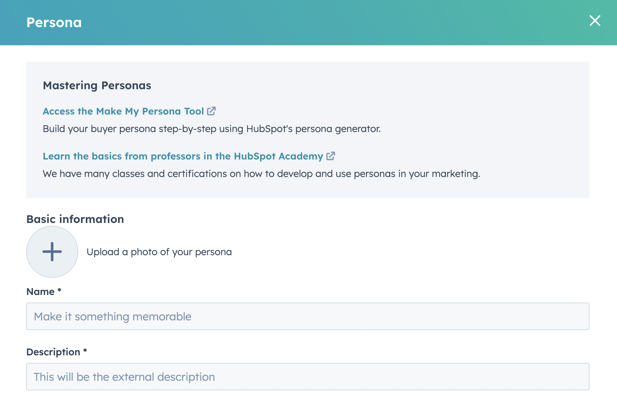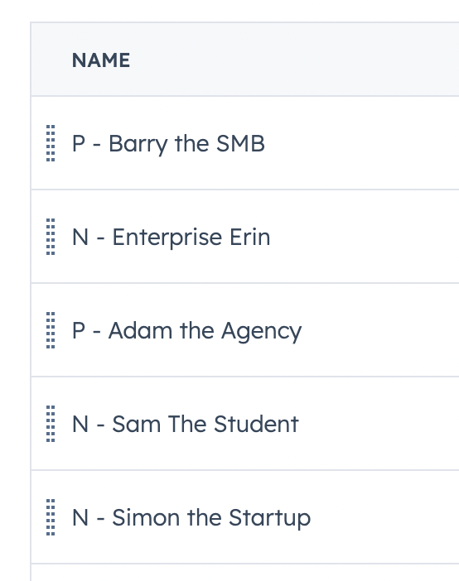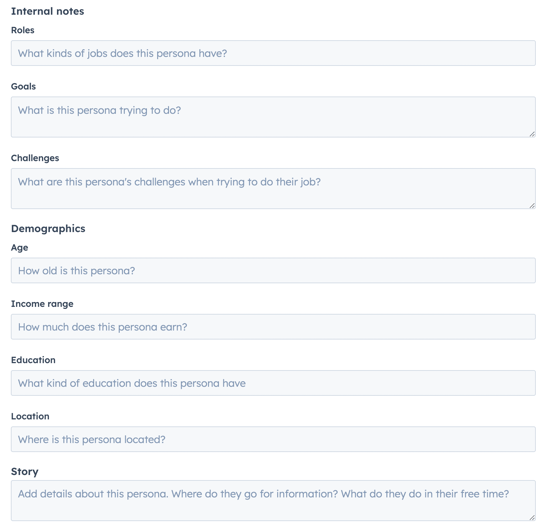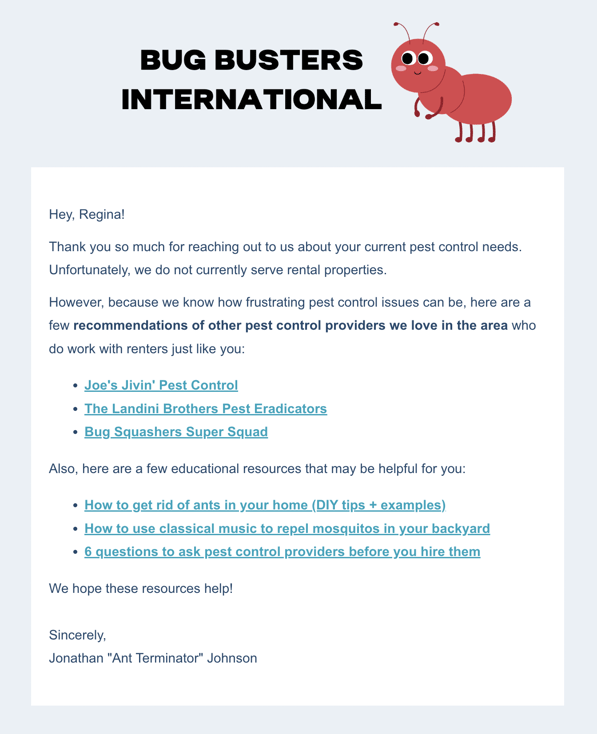8 min read
George's crazy simple guide to getting started with HubSpot buyer personas (+ examples)
 George B. Thomas
Jul 6, 2023 11:34:31 AM
George B. Thomas
Jul 6, 2023 11:34:31 AM
Rather listen to this post?
Buyer personas are a fundamental building block of the inbound methodology. If you've been kicking around the HubSpot ecosystem for any length of time, I know I'm not blowing your mind by dropping that little nugget of wisdom.
However, there's a very important reason why I want to take a bit of time with you today to talk about buyer personas, even if you consider yourself a buyer personas pro — so, listen up! We've got a couple of problems with the way we think about buyer personas and how we get them into HubSpot:
- We're defining buyer personas in the wrong way
- We're making the process way more complicated than it needs to be
Now, for those of you who may be scratching your heads going, "Wait a second, George ... we've been taught by HubSpot Academy and other folks that buyer personas are just semi-fictional representations of our ideal customers, based on research and data. How hard is that really to screw up? Seems kind of basic!"
Here's the thing, folks.
With all due respect to my friends at HubSpot, my definition of a buyer persona is dramatically different. And this is where our journey begins together today.
A buyer persona is a human being, plain and simple
More specifically, they're a human being with an aspiration or a goal they're trying to reach. As we group them together as collectives with a buyer persona, that's when we identify their patterns of problems or aspirations.
🎧 HubHeroes Podcast: What are buyer personas really? And who are they?
You see, the shift in mindset I'm suggesting here may seem inconsequential. Is there really that big of a difference in calling a buyer persona a human vs. a "semi-fictional representation of your ideal customer"? I'd argue there is.
Every single person who converts as a contact in your portal and gets assigned a buyer persona designation based on their responses to your contact form questions isn't fictional in any way, shape, or form. They're very real human beings.
And that's when things start to get exciting. Instead of abstractly wondering what fictionalized "Startup Steve" might be thinking about, we start asking ourselves questions about the real humans in our HubSpot portal that challenge us to truly connect with them:
- Who is this person and what do they do?
- What are they struggling with on a daily basis?
- Are they feeling pressured by anyone in their lives or at work?
- What are their goals or aspirations?
- Do they feel confident about their ability to achieve those goals or are they nervous?
- What motivated them to finally connect with us at this specific point in time?
When you start thinking this way about the contacts in your portal — and the buyer personas you create to help categorize them — that's when the real magic starts to happen. That's when you open the door to creating meaningful and lasting connections with the humans you're destined to serve.
⚡ Learn more: Join the all-star HubHeroes Community today
Your goal when you create personas isn't to create something fictional. Quite the opposite. You're reverse-engineering the very real, human stories of those you serve (and don't serve; more on that soon!) — who they are, what they do in their daily lives, what they're chasing, what they're running from, and how you're going to help them achieve their goals — into your personas.
Of course, we then need to talk about the other elephant in the room, right?
How freakin' long it usually takes to create buyer personas ... if they ever get done to a usable state in the first place.
When did creating buyer personas become so complex?
Here's something that blows my freakin' mind. I think we can all agree that buyer personas are a mission-critical part of the foundation you need to establish for any inbound-based marketing strategy, right?
But there are so many books and tutorials and videos and dense online guides out there on the topic that the very idea of creating buyer personas can seem crazy complex:
- You've got to have internal conversations with stakeholders across different teams
- You need to interview ideal customers who fall into the persona buckets you've identified
- You need to do research and collect data to validate your findings
- Heck, you may need to go through a formal voice of the customer exercise
- Then you've got to create a PowerPoint presentation to present your recommendations internally
- You need to integrate all of the feedback you've received on that work
- Then you'll create another presentation with the revised personas (lather, rinse, repeat as needed)
And then maybe six months to two years later, you've got fully baked out personas you can finally use. Assuming, of course, nothing has changed about your business or product strategy.
But for all that time, you've had contacts (fingers crossed!) starting conversations with you by converting on HubSpot forms on your website — downloading pieces of content, subscribing to a newsletter, or reaching out to contact you about your services.
🔎 Related: Is community a buzzword, marketing hack, or the key to your purpose?
How many opportunities have you missed for more personalized experiences through segmentation, or real intelligence gathering for your sales, marketing, and service teams because of a needlessly complex buyer persona creation process?
To be clear, I'm not dissing these in-depth buyer persona process recommendations. Not in the least! I'm not saying you shouldn't, at some point, take the time to build out buyer persona stories or conduct in-depth research.
My only point here is that, if you're looking to get up and running with buyer personas in HubSpot, there are ways to be more efficient. There are ways to be immediately more successful right from the moment you open up your portal and even think about buyer personas.
How to get started quickly with buyer personas
HubSpot's knowledge base provides a quick primer on where to find personas and create them, but let's simplify the complex. Personas can be found under Properties > Contact Properties in HubSpot. From there, type "persona" into the search bar and select "Persona."
When you open up the persona creation tool, you're going to find a ton of different things you can fill out. But if you look closely, you really only need to fill out two mandatory fields before you're off to the races, enabling new contacts to self-segment:

All you need to add in is a name and a description. You don't even need to add a photo if you don't want to, especially since all of the humans who may fall under a single buyer persona are unique.
When it comes to your name, you're going to want to include two things:
- Whether or not it's a positive persona or a negative persona (I'll show you an example)
- A name that is a clear description of the key characteristic that differentiates them
For example:

For each of these, you can quickly see if they're positive (P -) or negative (N -), as well as the identifying characteristic that differentiates them the most. In the example above, it's all about who they are or where they work (student vs. SMB vs. startup, and so on).
The internal description you set can provide a little more detail about your persona.
For example, "Barry is the owner or key decision-maker at an SMB company with five years experience. He's looking for help with HubSpot for his business." What you include in this description should correspond with characteristics a human can self-select when they're converting on a form — type of organization, their role, experience, etc.
🔎 Related: 6 must-know tactics and best practices for HubSpot Workflows
Now, like I said, when you first open that persona creation tool, you may feel overwhelmed by everything else that's in there:

You've got goals, roles, challenges, income, backstory, education, and on, and on, and on. This is where a lot of folks can get tripped up when they encounter buyer personas for the first time for their company. All of these details are "nice-to-haves," everybody. (OK, some of these may be essential, but I'll leave that up to you, because it depends on your business.)
🔎 Related: You need to write (and market) like a human being (+ examples)
Yes, fill this information out over time, through research. But by no means do you need to know that Renter Regina lives in Duluth, Minnesota, with a high school education and an average income of $65,000 per year in order to get up and running with your persona.
When it comes to building out your personas for the first time, so you can get going with HubSpot, start with the basics of what you and your sales team already know:
- Who your ideal customers are
- Who your ideal customers aren't
- The most core characteristics that differentiate them
With those basic pieces of information, you're in business. Well, almost.
Once more with feeling, don't forget the humans
Whatever you decide here has to be something the humans you're ultimately trying to attract can understand. Because what you're basically asking someone to answer through a form (which should match to whatever you decide for your personas) is this:
"How would you best describe yourself?"
That's a very human question.
So, think about the humans you're seeking to serve and how they would self-identify. It should be completely intuitive for them to identify the way you see them. "I'm Adam, and I'm an agency owner who needs help with HubSpot" (positive), or "I'm Sam, a student who's looking to learn more about HubSpot for a potential career in marketing" (negative).
Now, let's talk about why that's important.
Your personas help you figure out "who's in the room"
That's what creating buyer personas is all about. You've got a bunch of incredible humans (hopefully) starting conversations with you and becoming contacts in your HubSpot portal. Your HubSpot portal is the "room," we're talking about here — a digital room, if you want to be more accurate.
So, you've got a bunch of new humans running around the room. Who are they? Who's in the room?
When you set your personas up the right way, you're creating a way for those humans to self-identify who they are to you. That way, through quick and easy self-segmentation, you can immediately make your communications and strategies more targeted, personalized, and (my favorite word) human.
🎧 HubHeroes Podcast: Demystifying your customer buyer's journey
Now, they may end up being a "good" buyer persona or a "negative" buyer persona, depending on what answers they select when they convert on your site.
That's right, when we're talking about creating your buyer personas, you have to remember you can't just be thinking about identifying who it is you do want to serve. You also need a way to identify those who aren't the right fit — and that's where your negative buyer personas come in.
Remember to still treat negative personas positively
What constitutes a negative buyer persona for you will be unique to what it is you do or sell. Maybe it's someone who has a different budget in mind than how you price what you offer. Perhaps you offer pest control, but only to homeowners, not renters.
No matter what reason someone ends up self-identifying as a negative buyer persona, they should never be talked about (or to) negatively.
It's not "Cheapskate Charlie" who's in your portal. Maybe it's "Budget Benji," because it's not a bad thing to be a buyer who potentially skews a little more heavily in weighing budget when making a purchasing decision — heh, especially in this economy, right?
🎧 HubHeroes Podcast: What is customer delight, and who is responsible?
Plus, you can still create a helpful, human experience for those who may not be the right fit! For example, let's go back to the example above, where you potentially only offer services to homeowners rather than renters for pest control. Now, let's imagine for a moment that a renter converts on a contact form and self-segments based on their responses under your buyer persona "Renter Regina."
Instead of completely ignoring their response — or having a human on your sales team take time out of their day to reach out to this human who is a bad-fit already to begin with (when they could be talking to someone who is a good fit) — you could set up an automated HubSpot email that looks something like this:

With this approach — where you have negative personas set up with a positive interaction queued up — everyone wins:
- Regina doesn't leave with a negative feeling about your brand. In fact, she will likely leave the experience feeling positively about your brand, because you still went out of your way to be genuinely helpful. She may keep you in mind when she needs help in future and is a good fit!
- Your marketing team doesn't end up wasting time or resources on this contact. When she self-segments into the negative persona bucket, you can also have her excluded from other communications or activities reserved for those you are trying to nurture into customers.
- No one on your sales team loses time in their day having a phone or email conversation, just to tell her that she isn't a good fit. Instead, they can stay focused on conversations for those who are a good fit for what you do or sell.
Pretty incredible, right?
This is just the beginning when it comes to your buyer personas
What you've learned here today is what will get you into HubSpot and moving with buyer personas, so you can be more effective faster with your inbound activities. Because, the quicker you can empower the humans contacting you to tell you who they are, the quicker you'll be able to get laser-focused with your efforts.
But just because I'm saying you need to simplify your initial first steps in the creation of your buyer personas doesn't mean that's where your work should stop. You should continue to research. You should interview your ideal customers. You should continue to collect data.
You should always and forever remain a student of the humans you serve.
The key is to not let a lack of every single detail about those humans stop you from diving into the tool and getting started.
In fact, talk to your sales team, even if you've only got a sales team of one. You likely already have a ton of buyer persona intelligence under your roof, ready to be documented within HubSpot ... no hours of research or PowerPoint presentations required!


